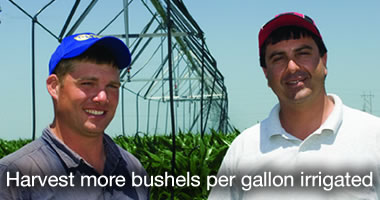 |
Bladen, Nebraska |
 Retired farmer Paul Krueger Jr. still refers to his installation of an irrigation well in the midst of the “dirty ’50s” as his “make or break gamble”. Thanks to that foresight, close to a half-century later his son, Paul Krueger III, is still farming the land and has hopes one of his three sons will continue the tradition.
Retired farmer Paul Krueger Jr. still refers to his installation of an irrigation well in the midst of the “dirty ’50s” as his “make or break gamble”. Thanks to that foresight, close to a half-century later his son, Paul Krueger III, is still farming the land and has hopes one of his three sons will continue the tradition.
Now the operation near Bladen, Nebraska, has expanded to 2,200 acres with 15 T-L center pivot systems, the first being installed in 1982. The original T-L center pivot is still applying water in its 21st season.
The younger Krueger says he finds this interesting for several reasons. “In spite of inflation and even though the latest systems have been refined and upgraded, the last T-L sprinkler we bought this past year cost just $2,600 more than my father’s original one. That amazes me,” says Krueger.
“Not only that, but in addition to routine maintenance we figure we’ve spent less than $500 total in repairs on it over more than two decades,” Krueger says. “Now that’s reliability.”
Krueger minimum-tills and no-tills his dry land acres, and ridge-tills the irrigated ground. Under irrigation his corn averages 185 bushels an acre and his soybeans in the low 60s. Average rainfall ranges between 18 to 24 inches annually, but half may arrive in a single month.
“Our soils are productive, and irrigation is what lets us capitalize on them and so maximize our yields,” Krueger explains. His father also experimented with gravity irrigation for many years. All those fields have since been converted to sprinkler irrigation, with great justification, not to mention relief, according to Krueger.
“You can stretch a sprinkler’s water so much further,” he notes. “For example, a 600 gallon a minute well that maybe would be lucky to do 80 acres under gravity can easily cover a full 130 acres through a pivot system.”
Then there’s the indisputable fact that gravity systems are extremely labor intensive. Krueger’s now getting all the farm work done with the help of one hired hand. If he had the same number of acres under gravity irrigation he says he’d need at least one more full time man plus “a bunch of seasonal help and we’d still be running ourselves ragged at times.”
“With the sprinklers, we just turn’em on and then drive around to check them a couple of times a day,” he smiles. The 15 T-L sprinklers can also readily handle all the ups and downs of the topography. However, in contrast, in one 80 acre field under gravity irrigation they were compelled to put in even more effort since the water had to run in all four directions.
There are also some things that a gravity system just can’t do that’s simply part of a sprinkler’s package of benefits, according to Krueger. One rotation of the sprinkler is enough to activate the applied herbicide if no rain falls nor is forecast immediately after planting.
Also, chemicals and fertilizer can be applied with later waterings. “We like to put on 30 to 40 additional pounds of nitrogen through the systems just before the corn ears start filling,” Krueger adds.
“That can be a pretty good bang for the buck.” A neighbor’s soybeans last year averaged in the upper 40s in a field adjacent to a Krueger field that averaged 65 bushels an acre. The main difference is the head end of the neighbor’s gravity irrigated field averaged 80 bushels an acre while the low end dropped into the low 30s.
Meanwhile, the Krueger soybeans yielded about the same throughout the field. Then there’s the question of reaching the end of the growing season and there isn’t enough moisture to finish off the crop. Under gravity irrigation there’s no choice but to pump out a full soil profile.
However, a sprinkler system can be cut down to apply only .75 inch or so of water, according to Krueger. This last irrigation would be enough for the crop’s needs, yet wouldn’t waste water.
“Compared to gravity irrigation, I think in an extreme year you can probably bank on 20 bushels an acre more corn from a sprinkler irrigated field,” Krueger is convinced. “There’s no argument that sprinklers provide much more uniformity that results in higher yields.”
“We’ve learned, too, that our T-L systems go even further than other sprinklers in providing this better uniformity,” he continues. “They move continuously as opposed to a start stop electrical system. There are none of the ‘spikes’ you see when you look at the water pattern drying up behind an electric sprinkler unit.”
“The T-L’s even water application is bound to translate into extra yield, which adds dollars to our bottom line,” Krueger says. You often hear farmers complaining about having to do their irrigating. Not Krueger. Because, as he points out, “Since we can’t depend on Mother Nature cooperating year-in, year-out, if we couldn’t irrigate, we would be growing wheat and grain sorghum instead of corn and soybeans.”
“I look forward every year to starting up our T-L sprinkler systems.” MAKE OR BREAK Irrigation Krueger has converted almost all of his center pivot irrigation systems to reduced pressure drop nozzles.
While he allows that on a “nice day” there may not be much difference in effectiveness between top nozzles and drop nozzles, unfortunately there just isn’t enough such ideal weather in his area. “On a 100 degree day when the wind is blowing 30 miles an hour you can see the water pattern coming off a top nozzle system misting off into the distance,” he observes. “Meanwhile the drop nozzles are getting the water right onto the soil,” Krueger says. “I think on such a day there’s at least a 30 to 40 percent savings in water with drop nozzles, and maybe as much as 50 percent.”
One of Krueger’s landlords has established a wildlife area in a corner of a field. Krueger stands by a Pheasants Forever sign in an area fronting the adjacent main road.
 |
Shickley, Nebraska |
 Mike Kamler, of Shickley, Nebraska, replaced gravity irrigation with ten electric enter-pivots in 1974. In 2001 he bought his first T-L system, and since then has added four more, all T-Ls. All feature drop nozzles with rotators irrigating mostly corn.
Mike Kamler, of Shickley, Nebraska, replaced gravity irrigation with ten electric enter-pivots in 1974. In 2001 he bought his first T-L system, and since then has added four more, all T-Ls. All feature drop nozzles with rotators irrigating mostly corn.
That first T-L has now run for seven seasons and 4,300 hours. The other three T-Ls each rack up 250 to 750 hours annually. Yet he’s never called his dealer to exclaim, “A pivot’s down! Hurry out!”
“I’d like to say my T-L dealer’s service is second to none, but I can’t,” Kamler comments with a twinkle. “That’s because in seven years I haven’t had a service call! The only problem I’ve had is when a cow rubbed against a pipe and broke it.”
All four T-Ls have planetary gear boxes. He’s found this to be worth the extra investment over worm gears, since he anticipates being able to run them 20 to 30 years without experiencing the gear box problems typical of electric systems. The galvanizing is also quite good, he thinks, and should result in long, rust-free lives.
Service maintenance has consisted solely of checking for grease in the fall, changing the filter and pumping air into the tires both spring and fall. He’s experienced no water issues.
The time needed to routinely service one of Kamler’s T-Ls averages an hour to an hour-and-a-half. For each electric unit, however, the time required is more like two-and-a-half to three hours.
He’s certain he can “Definitely!” see more uniformity in his T-L-irrigated fields due to the systems continuous movement. A few minutes spent up on an electric system’s tower while his son was at the pivot point doing the moving further convinced him.
“Its instantaneous jerk when it kicked into gear almost threw me off,” he says. “Also, there are going to be streaks in the field where an electric center-pivot stops and starts. I’m sure this affects yields. How much, I don’t know. But, whatever has a positive influence on yields puts more bushels in my bin.”
As for working on his electrics, Kamler explains that while he’s fairly comfortable around the high voltage electricity, it scares him. With 480 volts, all it would take is one slip, he cautions.
There’s an unusual developing downside for electric center-pivots in his area, too. Due to the present high price of copper, thieves are coming in and making off with the copper wiring.
“Combining T-L’s simplicity and reliability with a good dealer, I am confident about my T-L center-pivots. I just go out and start ‘em and run ‘em. I don’t have to work on ‘em. My T-Ls put money in my back pocket, I believe, because they need fewer repairs and less maintenance.
“Of course,” he admits, “no matter how good a machine is, some day it’s going to break down. That’s why it’s so important to have a good dealer, like mine, behind me.
“T-Ls are just so much better! Simpler and more reliable with low maintenance,” Kamler sums up, “for the same amount of money as electric, I just don’t see why you wouldn’t buy a T-L.”
Corner systems pay off
Kamler utilizes one T-L corner system on his landlord’s farm. His landlord was about fed up with corner systems at one point, though. That’s because the electric corner system on an electric center-pivot went down three times, the last time “falling like a dinosaur and just lying there”.
Then he decided to replace his electric with a T-L, including a corner system. The result: “It has probably 3,500 hours on it, and the unit has just been flawless,” says Kamler.
And, yes, at first glance a corner system might seem tough to justify, since it may cost an extra $1,200 an acre for each corner acre covered. Yet to purchase irrigated cropland in the area would require three times that much investment.
As Kamler explains, dry-land corn can produce anywhere from zero to 140 bushels an acre, depending on rainfall. Over the years, he figures, on an average, to have made 50 bushels an acre on his dry-land. With corn at $3.30 a bushels, that’s a gross of $165 an acre.
However, an irrigated corn average on his farm will be 200 to 220 bushels an acre. Call it 210 bushels, and that’s a gross of $693 an acre — making paying off the additional initial investment of a corner system a rather short-term thing.
Likes ridge-till
Saying there’s a pretty fine line between ridge-till and no-till, Kamler points out that he prefers working with ridges for several reasons: Water drains off of low spots better, the soil seems to warm up quicker in the spring, water has a place to go after a heavy rain, and if the corn goes down for some reason, it’s easier to get the picker snouts under it.
 |
Clay Center, Nebraska |
 “Irrigated agriculture is the backbone of the economy in our state. Water is the number one driving force of the economy in agriculture,” Dr. Suat Irmak, Department of Biological Systems Engineering, University of Nebraska, points out.
“Irrigated agriculture is the backbone of the economy in our state. Water is the number one driving force of the economy in agriculture,” Dr. Suat Irmak, Department of Biological Systems Engineering, University of Nebraska, points out.
He believes there are two “cutting edge” or critical irrigation areas that must be explored — and the sooner the better considering generally diminishing water supplies over much of the country.
The first is what he terms “deficit or limited irrigation practices”. This is the foundation of some of his current research. Crop coefficients over the last 30 years have been developed to determine crop water requirements for full irrigation settings with no water stress.
“However, when you go to deficit or limited irrigation, many things change,” Dr. Irmak says. “So, we need to develop new crop coefficients for deficit irrigation.”
In addition to potentially saving valuable water, such diminished irrigation could also be an important factor in paring the costs of progressively expensive fuel or electricity for pumping.
He says the second critical area is finding the right hybrids. In this case, these are the hybrids that can produce higher yields on less than the water ideally supplied by full irrigation.
After two years of preliminary research using subsurface drip irrigation, Dr. Irmak began a three-year project using the region’s much more common centerpivot irrigation.
A new T-L Irrigation center-pivot system was installed at the South Central Ag Lab, Clay Center, Nebraska, to irrigate a 40-acre circle containing 48 plots, each of .8 acres.
Note that the color plot diagram (right) shows three replications of four different levels of weekly irrigation except when rainfall exceeded the irrigation requirement as determined by evapotranspiration values. Soil water status was monitored by two different systems in numerous locations, one twice a week and one hourly.
The “full” irrigation rate of 9.5 inches of supplemental water in addition to rainfall served as the benchmark against which the other three were measured: 75 percent of the “full” rate, 60 percent and 50 percent. In addition, there were dryland tests at the corners that received only natural rainfall.
The T-L system was set to provide with each rotation in the various plots, for example: 1.16-inch for “full” irrigation, .87-inch for 75 percent, .70-inch for 60 percent and .58-inch for 50 percent for an irrigation event.
In each of the 48 plots, plus dryland areas, seven hybrids were planted to determine which hybrids could produce the most prof i table yields under a limited irrigation program that saved both water and pumping costs.
Also, the crop coefficients are being determined for these hybrids to assess whether crop coefficients show variations with hybrids.
According to Dr. Irmak, “We learned that hybrid selection is a critical factor to make maximum use of irrigation water under water-limiting conditions.”
The 2006 growing season was relatively wet, although it was extremely dry until mid-August. An interesting point: Even the 50 percent corn receiving just 4.7 inches of irrigation water still yielded more than 210 bushels an acre — roughly twice that of the dryland yields.
Yields increased linearly to approximately 200 bushels an acre at which diminishing returns started. This effectively illustrated that the return per inch of water applied was much less in the 200- to 250-bushel range as compared to the initial stage of the production function.
“I think the bottom line is that with good irrigation management, coupled with good soil and crop management practices, high yields can be maintained with limited irrigation,” Dr. Irmak sums up.
“In other words, this achieves the objective of harvesting more bushels per gallon of irrigation water!”
Water Saving Suggestion
“Monitoring soil moisture or crop water use is extremely critical, repeat extremely critical,” Dr. Irmak cautions. “A producer could possibly save a tremendous amount of water just by monitoring soil moisture.”
